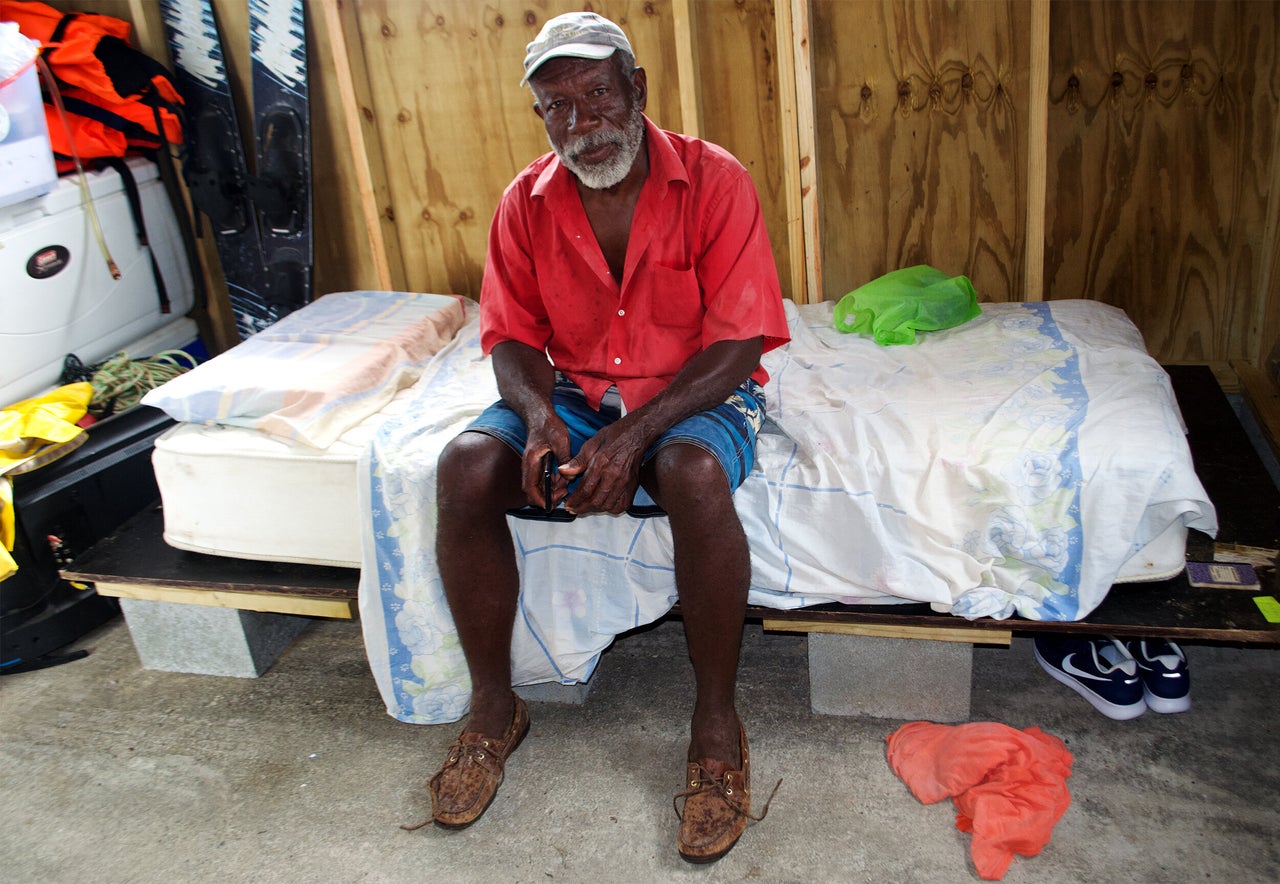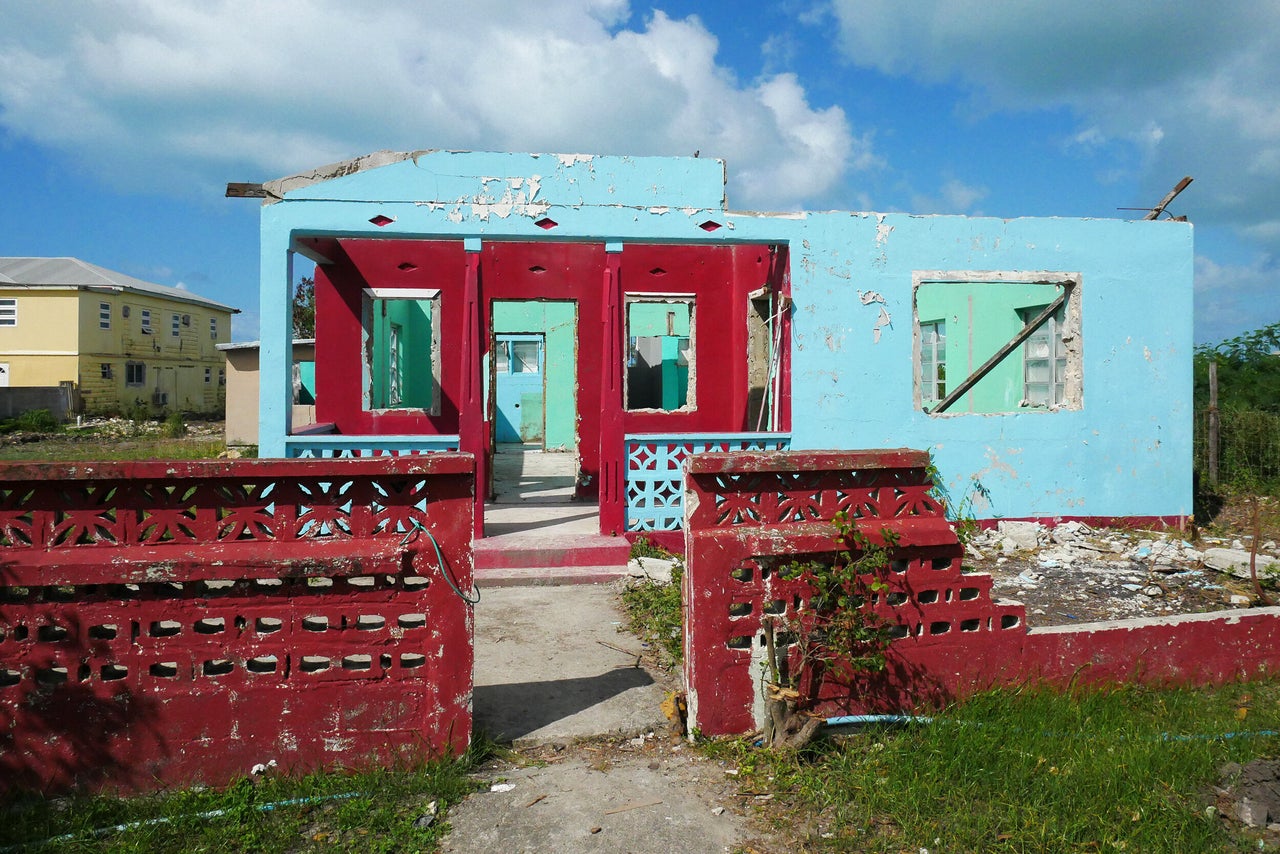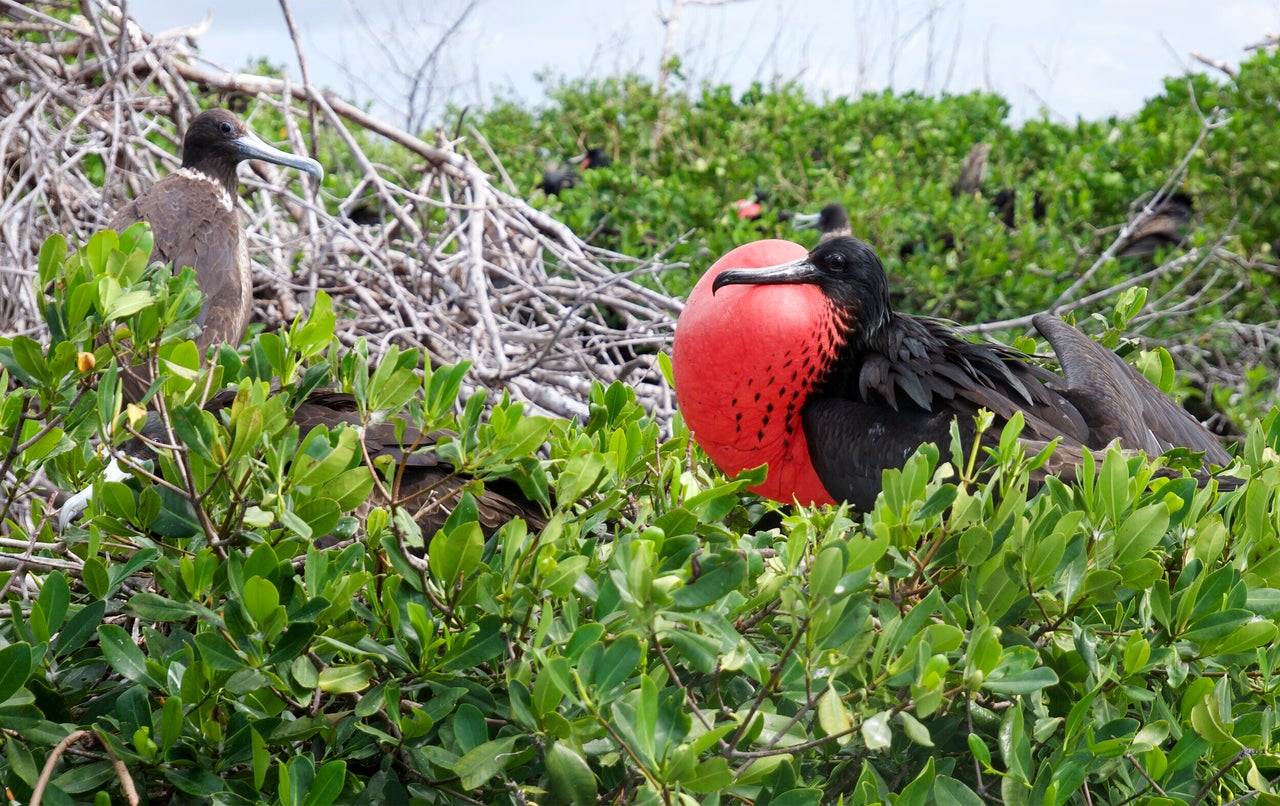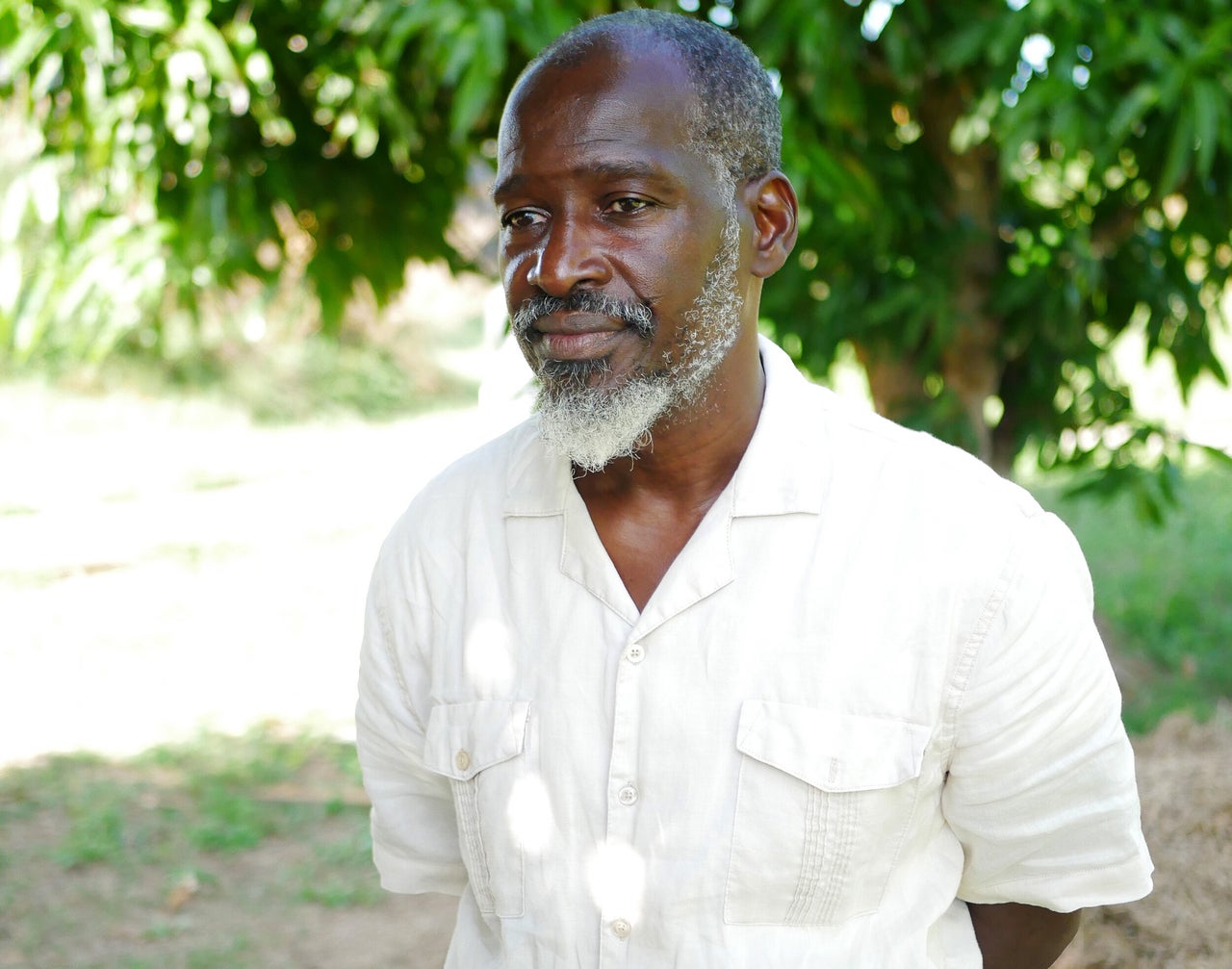What Will Be Lost is a series of reported stories and essays exploring the ways climate change is affecting our relationship to one another, to our sense of place, and to ourselves.
CODRINGTON, Barbuda — Two Foot Bay Road’s vibrant homes first grab your attention with their canary yellows, mint greens and salmon pinks. The next thing you notice are the sounds: passing bicycles, hee-hawing donkeys and blaring reggae music.
These are the sounds of everyday life in a place that relies on fishing and farming. Most Barbudans live here in Codrington, the island’s only town. The rest of its 62 square miles are mostly mangroves and scrubland.
But nearby Madison Square looks more like a checkerboard. Just inches from homes or shops with fresh coats of paint and shiny new roofs are blue tarpaulins fastened over the gaping holes of damaged homes, large piles of debris from what were once bustling small businesses, empty fields where produce once grew, shuttered museums. Many families are still sleeping in dilapidated white tents where they’ve been since Hurricane Irma devastated the island in September 2017.
“The hurricane blew my house top right off. It took everything,” said George Jeffrey, 67, as he tugged at the makeshift closure of his tattered tent. “This is my third tent. I’ve stayed in each one until it disintegrated.”
Irma, a Category 5 storm with winds up to 185 mph, was the most powerful Atlantic hurricane in recorded history. The damage in Barbuda totaled $222 million, and all the island’s 1,500 residents had to be evacuated to Antigua, its larger, more developed sister isle that’s about an hour and a half away by ferry.

Barbuda’s evacuation order was not lifted until three weeks after the storm. Damaged properties and businesses were left to rot. Most residents could only return for a few days at a time and often slept in tents in their yards. Local officials estimate that 25% of the population has not returned.
Barbuda’s landscape of beaches, coral reefs and forests had been largely untouched before the storm, even as other Caribbean islands developed into major tourist destinations. That’s due in part to the island’s system of communal land ownership that has been in place since slavery was abolished in 1834.
There is no individual private land ownership here. Barbudans can obtain plots for a house, farm or commercial use for free from the Barbuda Council, the local legislative body. The Barbuda Land Act of 2007 legitimized this system, and required a majority vote approval from the 11-member Barbuda Council for any major developments over $5.4 million. Only Barbudans and their descendants have rights to the land on the island.
But in the days following the storm, Antigua & Barbuda Prime Minister Gaston Browne moved to amend that act and introduce individual property rights on the island. This would open land to private purchase, and and to foreign investors seeking to build large-scale tourism developments. For many Barbudans, this looms as a bigger threat to their culture and way of life than the devastating storm.

The People’s Land
Antigua and Barbuda were unified as one nation in 1981, following independence from Great Britain. However, the country remains part of the Commonwealth, with Queen Elizabeth II as head of state. The relationship between the two islands has historically been tense, with political power centered in Antigua and Barbuda remaining the smaller, less populated island.
The prime minister has repeatedly referred to the Land Act as a “myth.” He says the law was just an attempt to give credibility to a long-standing belief that is not true, and that implementing private property is the only way to move the island forward. He suggested that in order to rebuild, Barbudans should be granted deeds for the land they already occupy, for a price of one Eastern Caribbean Dollar (about $0.37).
For many, this change would imperil what has been an essential element of their cultural and economic system ― not to mention the potential for big-money players to force Barbudans off lands they’ve lived on for generations.
Communal land ownership has been passed down through generations, and Barbudans say it is integral to their identity.
“This is a part of our culture. It is who we are as a people,” Jeffrey told HuffPost.
He said it’s about more than just who “owns” a plot of land. It’s the ability to enjoy all of the resources of the island like the Frigate Bird Sanctuary, the caves at Two Foot Bay and the beauty of the beaches at Palmetto Point, which is a Ramsar Site, ecosystems designated to be of international importance.

Rebecca Boger, an associate professor of environmental sciences at Brooklyn College who has collaborated with anthropologists to study the island’s unique cultural system, said the culture is tied to this way of life.
“They aren’t the first people to be on the island, but their identities and the common ownership and characteristics of their culture is very resonant of what it would be called indigenous peoples,” she said.
As the island recovers from Irma, Boger worries about the “death of a culture” that could come if that system is not preserved.
A Slow Recovery
The clearing of land for a new airport that cut through prime hunting and farming ground began soon after Irma, when Barbudans were not yet allowed to return to the island. Critics accuse the government of undertaking a land grab when the community was at its most vulnerable. An injunction to halt construction was granted in August 2018, but lifted a month later. Legal actions to reinstate the injunction are pending.
While most of Barbuda’s population has now returned, many have been without adequate housing or basic health, banking and education services as the third anniversary of the storm approaches. Electricity still has not been fully restored across the island. The only bank is open just two days a week with limited hours. Holy Trinity Primary School, the only primary school on the island, just reopened in January.
The island’s sole medical facility, Hannah Thomas Hospital, remains under construction. General medical needs are currently treated via “Clinic In A Can,” a mobile medical clinic that operates out of a shipping container-like structure. Any major medical needs require travel to Antigua.
“The recovery is slow,” said Tanesha Beazer, a mother of two whose family just moved out of a tent. Her mother and brother are still living in tents on the property where their homes once stood. “No running water, and when it comes to the bathroom, that’s the hard part ― because we’re outside.”
Delmarie Punter, owner of supermarket Del’s Superette, said the hurricane flattened her store. She lost everything.
“I don’t get any help to replace the store and some of the things that were in it,” she said. “I’m just trying to do little by little and try to see if I can get it back.”
Climate And Culture In Crisis
Islands across the Caribbean have seen an increase in the number of hurricanes and the extent of their damage. Scientists say climate change will only intensify those storms, as ocean temperatures get warmer, sea levels continue to rise and important ecosystems such as mangroves and coral reefs are eroded. Low-lying islands like Barbuda are especially vulnerable.
“Climate change, it has reached the stage of being a crisis now,” said John Mussington, a marine biologist and principal of Barbuda’s Sir McChesney George Secondary School. “Barbuda is at the forefront in terms of feeling the effects.”

But rather than focusing on mitigation and sustainable recovery for the people of Barbuda, many say the central government in Antigua is focusing on large-scale foreign investment for private tourism developments.
Mussington and other Barbudans have taken legal action, challenging the constitutionality of the repeal of the Land Act. A court date for that case has not yet been set, and the law remains in effect.
“I’m convinced that the Barbudan community, the people of Barbuda, we were not a priority,” Mussington said. “We were not meant to return to this island.”
It’s just another form of “disaster capitalism,” he said.
Antigua & Barbuda’s National Office of Disaster Service says this assessment is unfair.
“It is not a crime that Barbuda is recovering slowly,” said director Philmore Mullin, pointing to the ongoing recovery on other islands Irma hit.
Initial recovery estimates for Barbuda were three to five years, he said, but now he thinks it’s likely closer to eight to 10 years. “That is the reality of recovery,” Mullin said.
Barbuda has had to rely on the central government in Antigua, as well as international donor funding, for recovery. Mullin said Antigua’s central government sent all recovery funds directly to the United Nations Development Programme for distribution. He said this was done as a means of transparency and to dispel unfounded suspicions that funds were not being properly allocated for recovery needs. Mullin noted, however, that the Antiguan government does not have direct control over when and how those funds are dispersed.
He said a reason the recovery process has been slow is that, under normal circumstances, Antiguans facing property destruction can use their land and property titles to get loans for repairs. However, Barbudans can’t do that, because they don’t own the land.
Senator Knacyntar Nedd, parliamentary secretary in Antigua & Barbuda’s Ministry of Agriculture, Lands, Fisheries and Barbuda Affairs, said change is needed.
“The fact of the matter is, Barbuda needs development in the present state that it is,” she said. “We cannot continue to depend on the central government for financing.”
Nedd acknowledges that Barbudans have been told for years that the land is theirs without having to pay for it and are now being told the opposite. However, she said Barbuda is the property of the governor general, who represents Queen Elizabeth II. That will always overrule communal land ownership.
She said the current document the Barbuda Council issues to Barbudans gives them the right to occupy, not to own.
“It could never say that, because you cannot own it,” said Nedd. She explained that what the government is now trying to implement will give Barbudans true ownership.
Nedd said addressing the concerns of Barbudans has been one of her top priorities since she was appointed at the end of January. The Ministry of Agriculture, Lands, Fisheries and Barbuda Affairs is planning a meeting for key stakeholders, she said, though specifics on that have not yet been confirmed.
“This is Barbuda land, this belongs to the people and the people don’t want the island to be like Antigua,” Jeffrey said. “I’ve been here all my life and I’m not going anywhere.”
All involved — whether Antiguan or Barbudan — say they want the same thing: to see Barbuda recover and be “better” than it was before. That, however, is open for interpretation.
